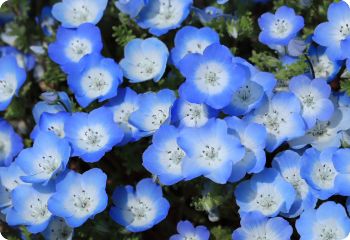
Last updated on May 20th, 2023 at 05:41 pm
Baby blue eyes are a beautiful flowering plant that grows in certain parts of California, especially in the Baja area. However, it is also found in many other states of America.
The scientific name of baby blue eyes is Nemophila. The plant features cup-shaped, 5-petaled flowers in different shades—purple, white, and blue. These stunning blooms add visual interest and color to any landscape.
Are you curious to know what baby blue eyes flower means? In Greek, Nemophila means a plant that is fond of meadows. In Latin, the word means a plant that loves wood. The truth is the plant likes sunny exposures and appreciates half-shades, which is uncommon with annuals.
Nemophila parviflora refers to “Smallflower Baby Blue Eyes” Meanwhile, Nemophila spatulata means “Sierra Baby Blue Eyes.” Last, “Eastwood Baby Blue Eyes” is the common name for Nemophila pulchella.
To elaborate more on the meaning of the baby blue eyes flower, Nemophila is a scientific name from two Greek words—the word “nemos” refers to “glade” or “wooden pasture;” on the other hand, the word “phileo” refers to “to love.”
Nemophila menziesii, or baby blue eyes, is a shrub-like, low-spreading plant with succulent flowers and stems with 6 curved blue petals. This flowering plant may have a height of six to twelve inches or fifteen to thirty-one cm. Its width is more than a foot or 31 cm. These flowers have a soft and romantic hue, which looks good with many other pastel blooms in native wildflower gardens.
Most species in this genus include the words “baby blue eyes” in the common names. That is due to the sky blue color of this flower.
What does the Baby blue eyes flower symbolize?
It is extremely enchanting to see baby blue eye flowers shining in the dews of the early morning. There is a deep relationship between this flowering plant with water that flourishes in the moist meadow’s watery womb. Its delicate leaves and stems grow very close to the soil.
Thus, its affinity for water is very pronounced. This flower symbolizes qualities such as trust, innocence, and tender sensitivity. These are usually related to a person’s early relationship with their dads or another prominent masculine figure, which are disturbed in some ways. The father was not present quite frequently, and there was no genuine presence or absence of support.
This beautiful bloom tries to cover the vulnerability over time with the help of a false “hardening.” Such feelings could be emotional distancing, cynicism, spiritual alienation, or mistrust.
The baby blue eyes are a flower, which is helpful for both men and women. However, it is particularly required for several men struggling to become stronger by ignoring their pain.
All in all, the baby blue eyes flowers symbolic meanings are:
- tender sensitivity
- innocence
- trust
- victory
- success
- healing
Meaning of the Baby blue eyes flower colors
Purple color
Nemophila maculata, or fivespot, is a spring-blooming annual plant. The leaves may measure up to 3 cm long by 1.5cm broad in terms of length and width. The lobes of the leaves are either smooth or serrated. They have a bowl-shaped, white blossom with black lines and dots. The tops of the lobes have purple spots.
Blue color
Annual flowers known as “Snapdragons” or Antirrhinum dwarf are a lot of fun. When you pinch the bottom of a flower, you can see the jaw open and shut. Because of this, it is often referred to as a “dog flower.” In the colder spring and autumn months, the vividly colored blossoms of snapdragons are at their peak.
White color
The beautiful white 1-1.5″ flowers of this California native are a sight to see. A 12-inch pile of scalloped leaves with white dots is completely engulfed.
Interesting facts about the Baby blue eyes flower
- Nemophila, or baby blue eyes flower, means the plant’s blooms are the primary reason for cultivating it.
- It produces huge cornflower blue blooms with a black mark in the center.
- This plant blooms all summer long if seeds are put in early in the spring.
- The blossoms don’t generate a strong aroma but are enormous and vivid.
How to grow Baby blue eyes flowers
Did you know that baby blue eyes are a beautiful flowering plant to use in containers and rockeries and also massed in annual gardens as border plants? These flowers are among those that display annual color first after melting ice and snow.
As mentioned before, these plants are native wildflowers in arid zones and the state of California. Baby blue eyes are not difficult to grow and maintain as garden plants and are a crucial inclusion of the coastal prairie.
- When growing outside, a mixture of full sun and some shade is ideal. Even if it only receives a few hours of sunlight each day, baby blue eyes may thrive in shady locations.
- It’s best to keep it out of direct sunlight if you decide to keep it indoors. There should be adequate sunlight from windows facing north, east, and west to keep the thing alive year-round.
- During their active development, baby blue eyes require a lot of water. Water is often during the first 6 weeks of a plant’s life, especially during germination.
- Before planting the seeds, fertilizer may be put into the soil.
- Check the soil when the plant has finished blooming. Even though the plant needs water, it should not be overwatered. Watering the plant is no longer necessary after the blossoms have faded.
How to care for Baby blue eyes flowers
- Keep the soil moist but do not let water accumulate.
- Fertilize the baby blue eyes once in spring.
- Trim the diseased, withered leaves once a month.
Best time to gift Baby blue eyes flowers
In April, the Nemophila flower, associated with blooms, is a favorite among Japanese gardeners. Their baby blue color contrasts with the springtime hues of pink and yellow, making these blooms a popular choice for photographers and flower lovers.
Hitachinaka Seaside Park nemophila, or “baby blue eyes,” as they are often known, are renowned across the globe. The English word nemophila was used to give the Japanese word “nemophila” its Japanese cultural connotations and significance.
Perhaps this is because nemophila is not native to Japan. They are said to symbolize both achievement and forgiveness in English symbolism.
Baby blue eyes bloom until early summer and late spring, so you know when to give these flowers as a gift to your loved ones.
Conclusion
The baby blue eyes flowers, with their vibrant colors and beautiful form, are sure to light up any garden space.
Baby blue eyes’ essence reconnects you with your spiritual nature’s infantile purity, allowing you to absorb love and support from people and life itself.
If you want to know and learn more about flowers, we at PansyMaiden can help you. Check out our fun, easy-to-read, and informative flower-related content that you will surely enjoy!

